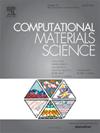Design of novel interpretable deep learning framework for microstructure–property relationships in nickel and cobalt based superalloys
IF 3.3
3区 材料科学
Q2 MATERIALS SCIENCE, MULTIDISCIPLINARY
引用次数: 0
Abstract
Featurization of microstructures is one of the most fundamental challenges in establishing microstructure–property relationships. Conventional machine learning and statistical methods require explicit featurization methods such as image processing, which are difficult to implement for complex and diverse sets of microstructures. To this end, deep learning methods such as convolution neural networks (CNNs) have been used to automate the featurization based on target properties. However, these CNNs do not include composition information limiting them to a single set of compositions. Moreover, these networks are complex and difficult to interpret. To overcome these challenges, a deep learning mixed input network consisting of a convolutional neural network (CNN) for microstructure input and an artificial neural network (ANN) for composition input is developed to predict the Vickers hardness of nickel and cobalt-based superalloys. A unique three-step optimization procedure is employed to reduce the complexity of the network. The network architecture is designed based on hardening models which allows the analysis of contributions of precipitation hardening and solid solution strengthening to the Vickers hardness. The network has been analyzed using synthetically generated controlled microstructures to understand the effect of microstructural features on the hardness. Furthermore, SHAPley additive explanations (SHAP) analysis has been used to understand the effect of composition and assess the interdependence between microstructure and composition in determining hardness.

镍钴基高温合金微观结构-性能关系的新型可解释深度学习框架设计
微观结构的表征是建立微观结构-性能关系的最基本挑战之一。传统的机器学习和统计方法需要明确的特征化方法,如图像处理,这很难实现复杂和多样化的微观结构集。为此,卷积神经网络(cnn)等深度学习方法已被用于基于目标属性的自动化特征化。然而,这些cnn不包括作曲信息,将它们限制在一组作曲中。此外,这些网络很复杂,很难解释。为了克服这些挑战,开发了一种深度学习混合输入网络,该网络由用于显微组织输入的卷积神经网络(CNN)和用于成分输入的人工神经网络(ANN)组成,用于预测镍基和钴基高温合金的维氏硬度。采用独特的三步优化方法,降低了网络的复杂度。基于硬化模型设计了网络结构,分析了沉淀硬化和固溶强化对维氏硬度的贡献。利用综合生成的控制显微组织对网络进行分析,了解显微组织特征对硬度的影响。此外,还采用SHAPley加性解释(SHAP)分析来了解成分对硬度的影响,并评估显微组织与成分在硬度决定中的相互关系。
本文章由计算机程序翻译,如有差异,请以英文原文为准。
求助全文
约1分钟内获得全文
求助全文
来源期刊

Computational Materials Science
工程技术-材料科学:综合
CiteScore
6.50
自引率
6.10%
发文量
665
审稿时长
26 days
期刊介绍:
The goal of Computational Materials Science is to report on results that provide new or unique insights into, or significantly expand our understanding of, the properties of materials or phenomena associated with their design, synthesis, processing, characterization, and utilization. To be relevant to the journal, the results should be applied or applicable to specific material systems that are discussed within the submission.
 求助内容:
求助内容: 应助结果提醒方式:
应助结果提醒方式:


